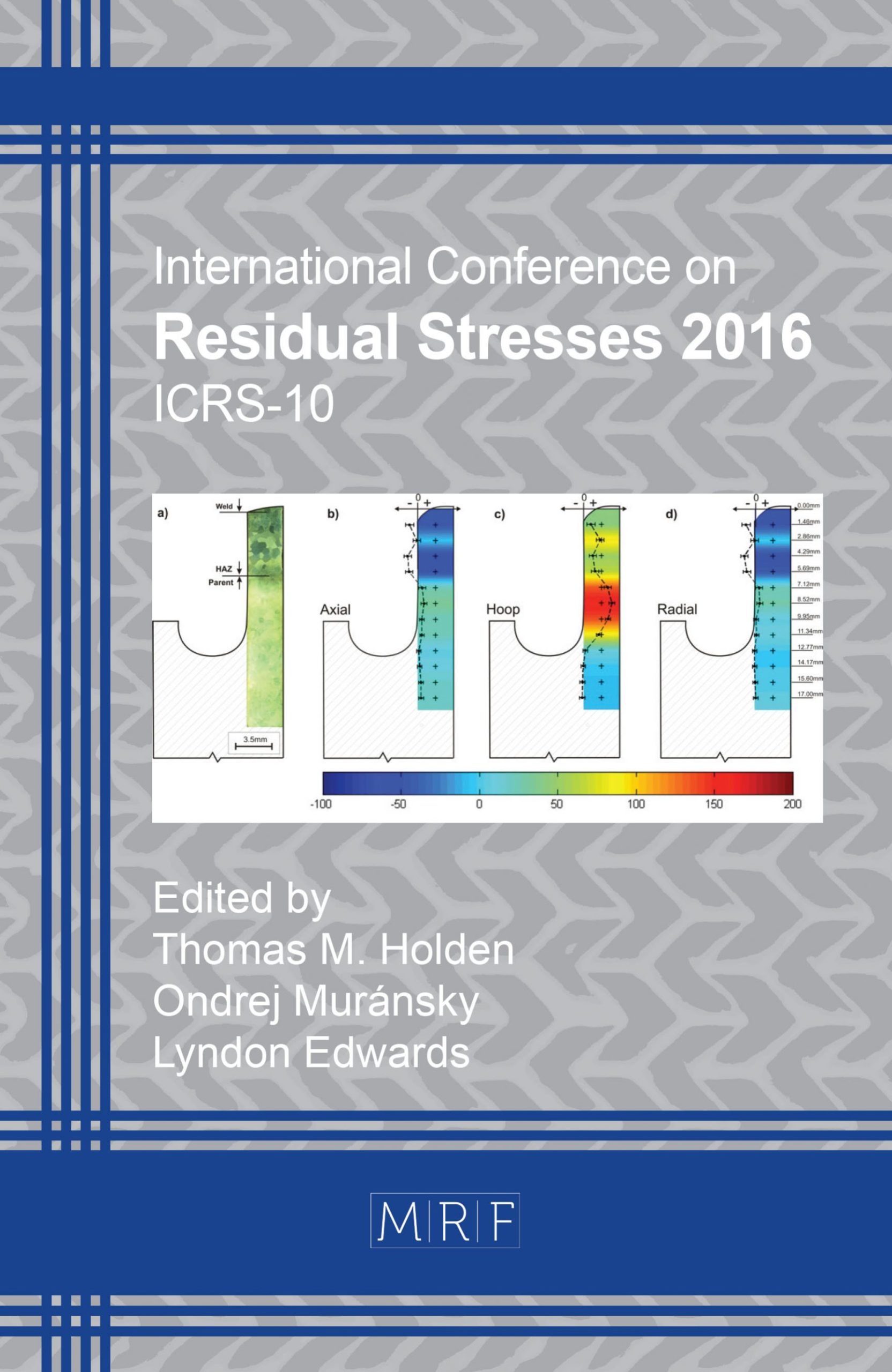Challenges of Measuring Residual Stresses in Large Girth Welded Pipe Spools by Neutron Diffraction
Y. Ren, A. Paradowska, E. Eren, B. Wang
download PDFAbstract. In this paper, welding induced residual stresses in a welded API 5L X65 girth pipe spools are discussed in as-welded and in local post weld heat treated conditions. Stress measurements were carried out non-destructively using the neutron diffraction technique. For such large-scale components residual stress measurements require significant preparation and planning. First of all, a choice of stress free lattice spacing value, discussed extensively, is of great importance for the evaluation of residual strains and stresses correctly. Besides, the use of a virtual instrument (SSCANSS software) can optimize measurements for distorted or undistorted large components with or without complex details. Moreover, the well-planned “window” cut through the thickness greatly reduced measurement time. A number of points were measured across the weld, HAZ and the parent material. Measurement results showed that residual stresses in the as-welded condition was lower than the yield strength of the material, and significant relaxation was also observed in the post weld heat treated samples.
Keywords
Residual Stress, Neutron Diffraction, Girth Welded Pipe
Published online 12/22/2016, 6 pages
Copyright © 2016 by the author(s)
Published under license by Materials Research Forum LLC., Millersville PA, USA
Citation: Y. Ren, A. Paradowska, E. Eren, B. Wang, ‘Challenges of Measuring Residual Stresses in Large Girth Welded Pipe Spools by Neutron Diffraction’, Materials Research Proceedings, Vol. 2, pp 575-580, 2017
DOI: http://dx.doi.org/10.21741/9781945291173-97
The article was published as article 97 of the book Residual Stresses 2016
![]() Content from this work may be used under the terms of the Creative Commons Attribution 3.0 licence. Any further distribution of this work must maintain attribution to the author(s) and the title of the work, journal citation and DOI.
Content from this work may be used under the terms of the Creative Commons Attribution 3.0 licence. Any further distribution of this work must maintain attribution to the author(s) and the title of the work, journal citation and DOI.
References
[1] R. H. Leggatt, “Residual stresses in welded structures,” Int. J. Press. Vessel. Pip., vol. 85, no. 3, pp. 144–151, Mar. 2008. http://dx.doi.org/10.1016/j.ijpvp.2007.10.004
[2] T. Lorentzen, “Nondestructive evaluation of residual stresses by neutron diffraction,” NDT Int., vol. 21, no. 6, pp. 385–388, Dec. 1988. http://dx.doi.org/10.1016/0963-8695(88)90160-0
[3] G. Albertini, G. Bruno, P. Calbucci, F. Fiori, M. Rogante, and F. Rustichelli, “Non-destructive determination of residual stresses in welded components using neutron diffraction,” Weld. Int., vol. 12, no. 9, pp. 698–703, Jan. 1998. http://dx.doi.org/10.1080/09507119809452037
[4] M. J. Park, H. N. Yang, D. Y. Jang, J. S. Kim, and T. E. Jin, “Residual stress measurement on welded specimen by neutron diffraction,” J. Mater. Process. Technol., vol. 155–156, pp. 1171–1177, Nov. 2004. http://dx.doi.org/10.1016/j.jmatprotec.2004.04.393
[5] A. Paradowska, J. W. H. Price, R. Ibrahim, T. R. Finlayson, R. Blevins, and M. Ripley, “Residual stress measurements by neutron diffraction in multi-bead welding,” Phys. B Condens. Matter, vol. 385–386, pp. 890–893, Nov. 2006.
[6] Y. V Taran, a M. Balagurov, J. Schreiber, and U. Stuhr, “Residual stresses in a shape welded steel tube by neutron diffraction,” J. Phys. Condens. Matter, vol. 20, no. 10, p. 104258, Mar. 2008. http://dx.doi.org/10.1088/0953-8984/20/10/104258
[7] T. Neeraj, T. Gnäupel-Herold, H. J. Prask, and R. Ayer, “Residual stresses in girth welds of carbon steel pipes: neutron diffraction analysis,” Sci. Technol. Weld. Join., vol. 16, no. 3, pp. 249–253, Apr. 2011. http://dx.doi.org/10.1179/1362171810Y.0000000028
[8] S. V. Pearce and V. M. Linton, “Neutron diffraction measurement of residual stress in high strength, highly restrained, thick section steel welds,” Phys. B Condens. Matter, vol. 385–386, pp. 590–593, Nov. 2006.
[9] W. Woo, V. Em, P. Mikula, G.-B. An, and B.-S. Seong, “Neutron diffraction measurements of residual stresses in a 50mm thick weld,” Mater. Sci. Eng. A, vol. 528, no. 12, pp. 4120–4124, May 2011. http://dx.doi.org/10.1016/j.msea.2011.02.009
[10] W. Woo, V. T. Em, B. S. Seong, P. Mikula, and G. B. An, “Residual stress determination in a thick ferritic steel weld plate using neutron diffraction,” J. Mater. Sci., vol. 47, no. 14, pp. 5617–5623, Apr. 2012. http://dx.doi.org/10.1007/s10853-012-6456-5
[11] G. E. Bacon, Neutron diffraction, 3rd ed. United Kingdom: Clarendon Press., 1975.
[12] P. J. Withers, M. Preuss, A. Steuwer, and J. W. L. Pang, “Research papers methods for obtaining the strain-free lattice parameter when using diffraction to determine residual stress research papers,” pp. 891–904, 2008.
[13] Paradowska, A., Finlayson, T., Price, J.W.H., Steuwer A., Ibrahim, R., Ripley, M., Investigation of Reference Samples for Residual Strain Measurements in a Welded Specimen by Neutron and Synchrotron X-ray Diffraction, Physica B: Condensed Matter, 2006, 385-389:890-893. http://dx.doi.org/10.1016/j.physb.2006.05.241
[14] Y. Ren, A. Paradowska, B. Wang, and E. Eren, “PVP2016-63378,” in Proceedings of the ASME 2016 Pressure Vessels and Piping Conference, 2016, pp. 1–9.
[15] J.A. James, L. Edwards, Application of robot kinematics methods to the simulation and control of neutron beam line positioning systems. Nuclear Instruments and Methods in Physics Research A., 2007, 571: 709-718.T. Manns; B. Scholtes, “DECcalc – A Program for the Calculation of Diffraction Elastic Constants from Single Crystal Coefficients,” Mater. Sci. Forum, vol. 681, no. 2, pp. 417–419. http://dx.doi.org/10.1016/j.nima.2006.11.033
[16] BSI, “BS7910:2013 Guide to methods for assessing the acceptability of flaws in metallic structures,” 2013.































